Alleviation: An International Journal of Nutrition, Gender & Social Development, ISSN 2348-9340
Volume 3, Number 3 (2016) : 32-36
©Arya PG College, Panipat & Business Press India Publication, Delhi
www.aryapgcollege.com, www.apcjournals.com
Human Resource Management Practices of Hotels: Satisfaction of Employees
1. Sneha Jaiswal* & 2. Dr. Maneesha Shukul
1 Teaching Assistant & 2 Professor
Department of Family and Community Resource Management Faculty of Family and Community Sciences
The Maharaja Sayajirao University of Baroda, Vadodara (Gujarat), India
*Email: Sneha.jaiswal0011@gmail.com
Introduction
The hotel industry has emerged due to the invention of four wheels when people began to travel and the logistic of carrying food for several days became a problem. Hence, at convenient spots, informal lodging operators started providing places to stay and eat in exchange of goods or money” (George 2010). In a labour intensive industry such as hotel industry, the effective use of human resources can give to it a competitive advantage. In the hotel industry, which involves both production and service aspects, creation and rendering of services from the hotel to the customer are primarily achieved through its employees. So the success of this industry depends on the efficiency of its employees and how effectively they are managed in its routine acts. Thus, it is essential that the hotel industry should formulate better human resource management practices that enable the industry to retain competent employees. The time has changed and role of human resource within the organization needs to be changed. Hence a study was conducted with an aim to assess the extent of satisfaction of the employees in hotel industry regarding human resource management practices followed by them.
The human resource management practices in hotel industry were selected for the present study because this area is less studied and there is a need for them to assess the extent of satisfaction experienced by their staff members. By improving their human resources, they can increase the volume of their business.
The empirical studies within and outside India focused on different perspective of human resource management and practices in hotel industry (Chand and Katou 2007 conducted a study on the impact of HRM practices on organizational performance in the Indian hotel industry, Mohsin and Kumar 2010 conducted a study on empowerment education and practice in luxury hotels of New Delhi, Rajesh 2012 conducted a study on human resource management practices in hotel industry in Kerala, Wynne 1993 presented a research paper on power relationship and empowerment in hotels, Yang 2010 conducted a study on human resource management in the hotel industry in Taiwan). The researcher could not find any study related to human resource management practices and the satisfaction level of employees of hotel industry in Gujarat state where the industries are fast growing and Gujarat is hub of industries. Hence the investigator was inspired to undertake the present research with the following objective in mind:
1) To find out the extent of satisfaction of the employees towards human resource management practices followed by selected hotels of Vadodara city.
Methodology
The research design of the present study was descriptive in nature. It was conducted in Vadodara city in the year 2015. A sample of 15 hotels (3 star, 4 star, and 5 star) was selected through convenience sampling from Vadodara city. A sample of 150 employees from the same hotels (10 from each) was the unit of enquiry. A satisfaction scale contained the sub aspects namely recruitment and selection, training and development, performance appraisal, compensation and promotion. The responses of employees were scored on a three point continuum as, Highly satisfied, Somewhat satisfied and Least satisfied. The positive question responses were scored as 3, 2, 1 respectively whereas the scoring for negative statements was reversed. The data were analyzed by applying descriptive (Frequencies, percentages, means, & standard deviations) as well as relational statistics (‘t’ test, Analysis of Variance, Scheffe’s test, & Co-efficient of Correlation).
Results and Discussions
Background Information of the Hotel
The background information of the hotel deals with year of establishment, ownership status of the selected hotels, chain of hotels, size of the hotels and star rating of the hotel. The human resource managers provided the information about hotels.
The findings revealed that a little less than one half of the hotels were established between less than 5 years (Table 1). A wide majority of the hotels were private limited as their ownership status. Little less than one half of the hotels were chain hotels. Two third of large size hotel and majority of the hotels were in category of 3 star.
Background Information of Employees
This section deals with background information of the employees which includes their age, education, gender and monthly income.
From these hotels, a sample of 150 employees was selected through convenience sampling method. The findings revealed that mean age of the employees was 28.8 years, one fourth of the employees had undergraduate diploma in hotel management (Table 2). A wide majority of the employees were males. Maximum of the employees had income ranging between Rs 5000 to 15000. The mean income was 14, 554 rupees.
Information Regarding Occupation of the Employees
The employee’s information about the nature of their employment, work experience, and the department in which they work is reported here.
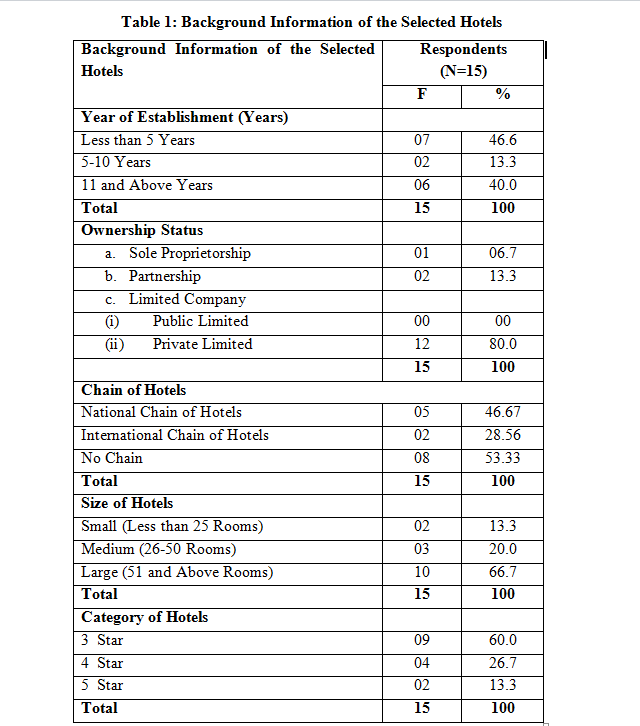
All employees had permanent employment (Table 3). Majority of the employees had total work experience of 2 to 6 years and 85 per cent of the employees had 2 to 6 years of work experience in present hotel. A little less than one third of the employees had same percentage for front office, food and beverage service and housekeeping department.
Overall Extent of Satisfaction Experienced by the Employees of the Selected Hotels:
Overall View
The overall extent of satisfaction experienced by the employees was considered on the basis of scores obtained by them on each satisfaction scale. The scores were divided into three categories to express High, Moderate, and Least extent of satisfaction on the basis of equal interval.
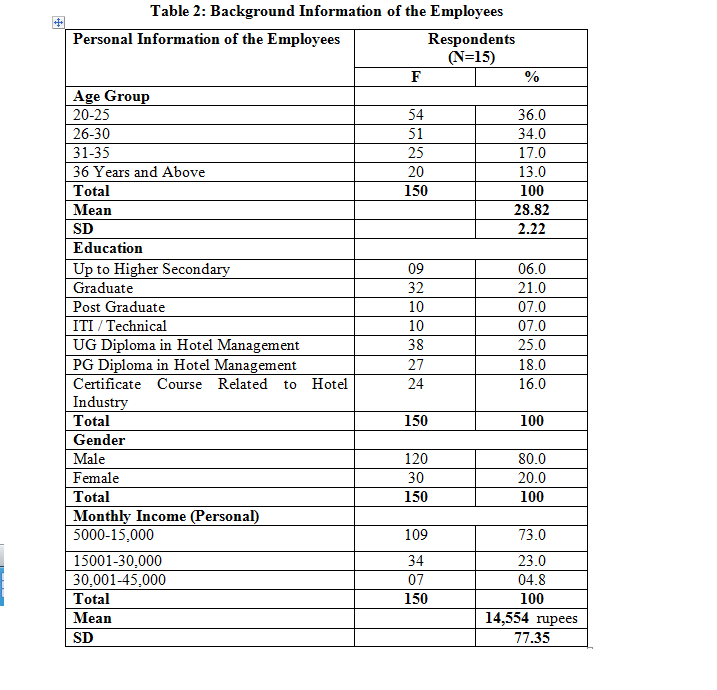
It was found that employees ranging between 42 to 64 per cent were moderately satisfied with almost all the human resource management practices followed by hotels (Fig 1). More than one third of the employees were “highly” satisfied with the practices regarding “compensation” (37%) and “recruitment and selection” (33%). Little more than half of the employees were “moderately” satisfied with the practices of “promotion” (53%), and “motivation” (51%), whereas one-fourth of the employees had least extent of satisfaction regarding “training and development” (25%) and little more than one fifth of the employees had least satisfaction regarding practices of “performance appraisal” (23%).
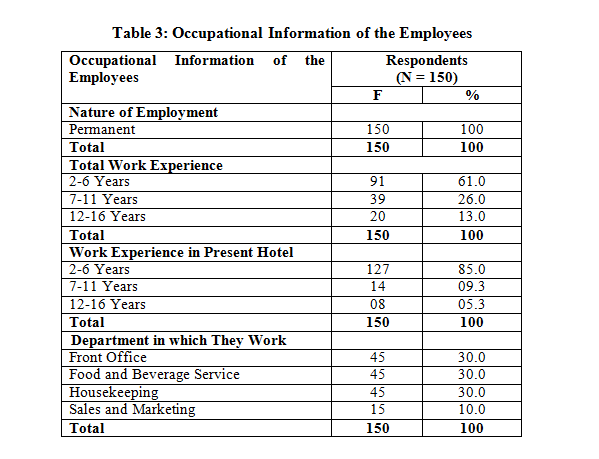
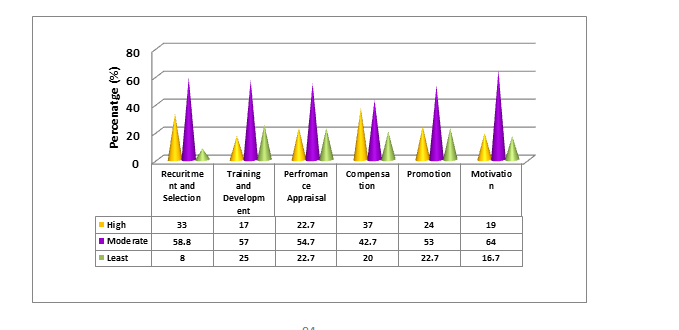
Fig 1: Overall Extent of Satisfaction Experienced by the Employees of the Selected Hotels:
Overall View
The overall data revealed that a little less than two third of the employees were moderately satisfied with the human resource management practices (Fig 2). About seventeen per cent of the employees were least satisfied and 19.3 per cent of the employees were highly satisfied with the human resource management practices.
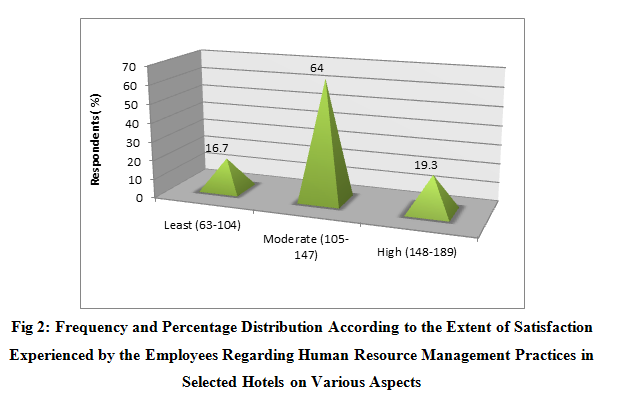
Weighted Mean of Extent of Satisfaction of the Employees: The weighted mean (Item Intensity) for each of the statements and for the entire scale of extent of satisfaction of the employees was found.
The weighted mean (2.16) showed that employees were highly satisfied with the practices of “recruitment and selection” whereas, they were least satisfied with the practices of training and development (Weighted mean 1.93), and “promotion” (Weighted mean 1.96) (Fig 3).
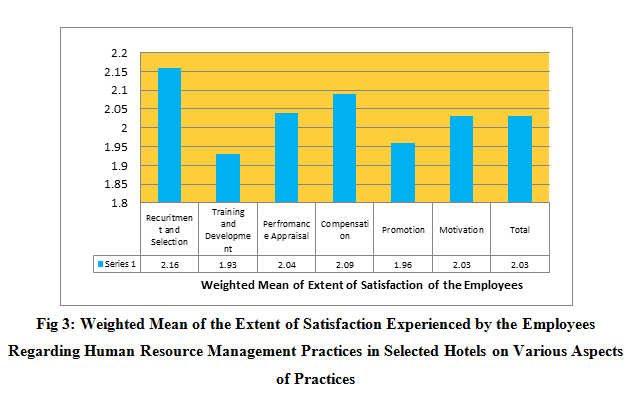
Testing of Hypotheses
The computed ‘F-ratio’ revealed that the extent of satisfaction of employees towards human resource management practices varied with the star rating of the hotel and size of the hotel. Thus, the null hypothesis was rejected. The result of scheffe’s test revealed that the satisfaction differed significantly from 5 star hotels to 4 star hotels and to 3 star hotels. Hence, it could be concluded that the 5 star hotels employees had higher satisfaction than other group on the basis of mean. The result of Scheffe’s test revealed that the satisfaction differed significantly from large size hotels to medium size and to small size of the hotel. From the mean, it could be concluded that the employees of large size hotels had higher positive satisfaction than other groups.
The results of ANOVA revealed that the extent of satisfaction experienced by the employees of the hotel regarding human resource management practices did not vary with the variability of department. Thus the null hypothesis was accepted. It was also found that the calculated ‘F’ ratio for education of the employees was found to be significant. Hence, the null hypotheses were rejected. It was found that the employees did not differ significantly in their practices due to gender. Hence, the null hypothesis was accepted. The results revealed that a significant positive relationship existed between the extent of satisfaction experienced by the employees of selected hotels for practices followed in the selected hotels due to age, income, total work experience, and work experience in present hotel.
Conclusions
It was found that majority of the employees were moderately satisfied with the aspects of human resource management practices followed in hotel. The findings showed that the employees were least satisfied with the practices of training and development and promotion. The feedback was given to the hotel industry and human resource managers that if the practices were followed in a better way, then the satisfaction of the employees would be high and so the growth and success of the organization would be achieved.
References
Chand M and Katou AA (2007) The Impact of HRM Practices on Organizational Performance in the Indian Hotel Industry. Journal of Employee Relation 29(6): 576-594, Retrieved on 27th April 2014 from 10.1108/01425450710826096.
George B (2010) Food and Beverage Service. Delhi: Jaico Publishing House.
Mohsin A and Kumar B (2013) Empowerment Education and Practices in Luxury Hotels of New Delhi, India. Journal of Hospitality & Tourism Education 22 (4): 43-50,Retrieved on 11th September 2014 from http://www.hospitality & tourism/123456.
Rajesh (2012) Human Resource Management Practices in Hotel Industry in Kerala, Unpublished dissertation of Ph.D, the Faculty of Commerce, Mahatma Gandhi University, Kerala, Retrieved on 1st September 2014, from http://hdl.handle.net/10603/21380.
Wynne (1993) Power Relationship and Empowerment in Hotels. Emerald Insight Journal 15(2): 42-50, Retrieved on 10th September 2014 from http://www.emeraldinsight.com/doi/pdfplus/10.1108/014254593100318331.
Yang H (2007) Human Resource Management in the Hotel Industry in Taiwan, Hospitality Journal 15 (2): 88-92, Retrieved on 11 5th 2014, from http://www.e-bookspdf.org/download/thesis-title-for-hospitality-management.html.

